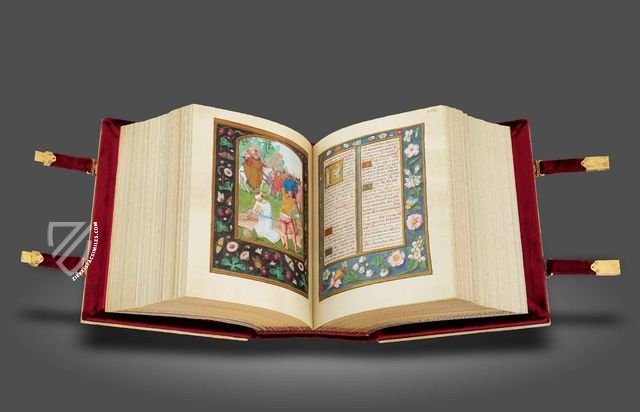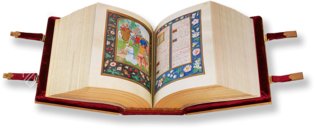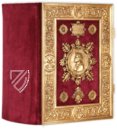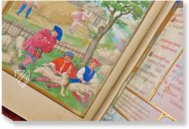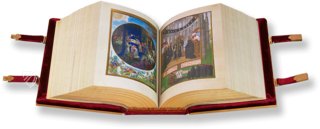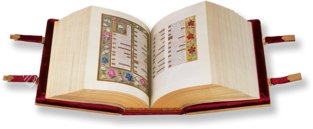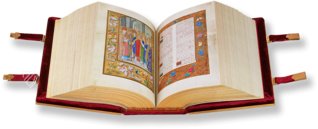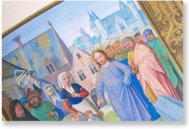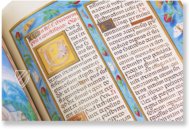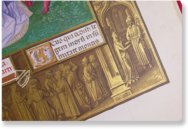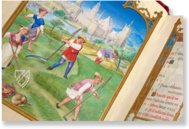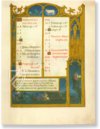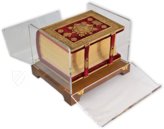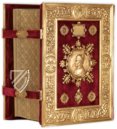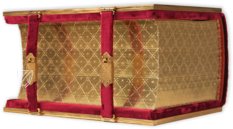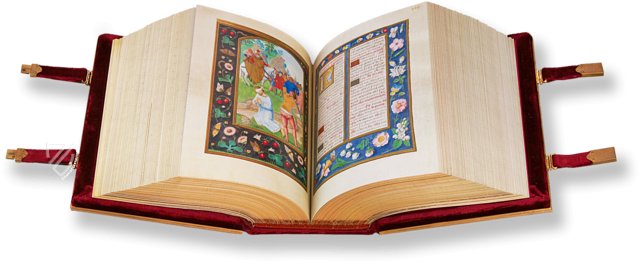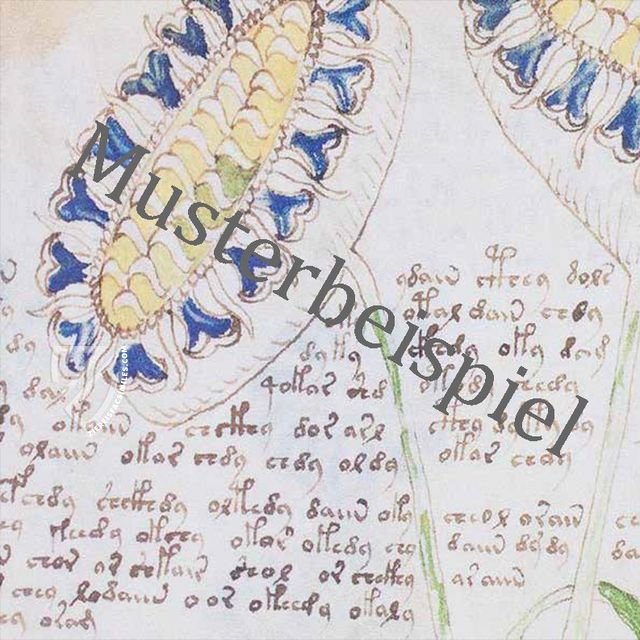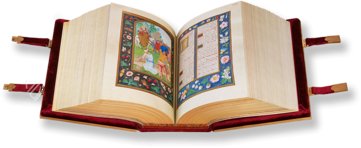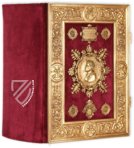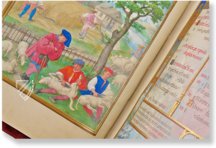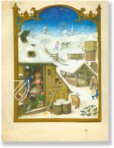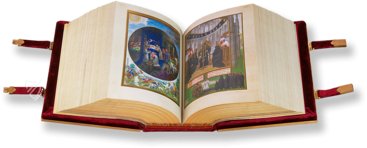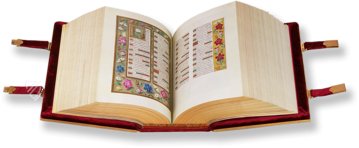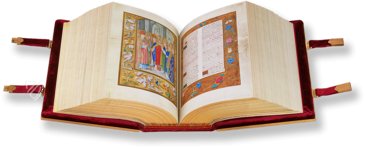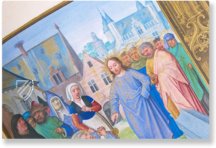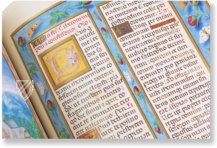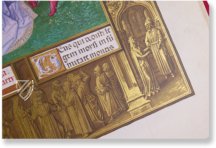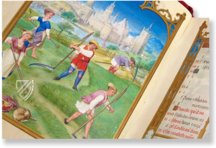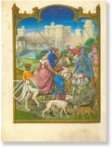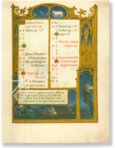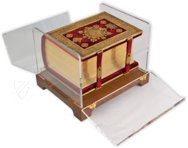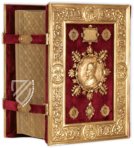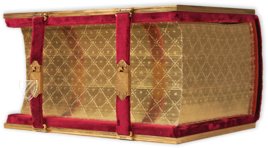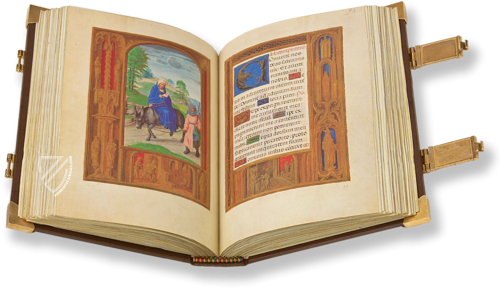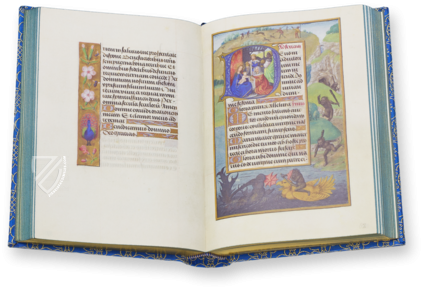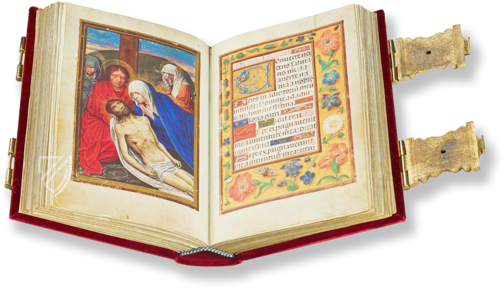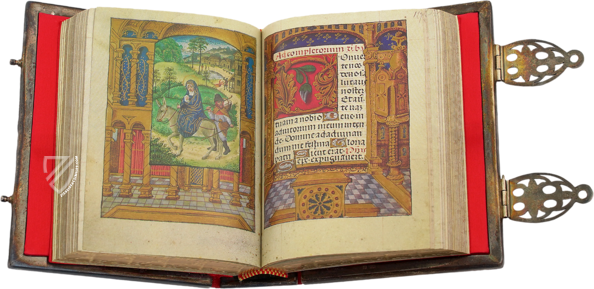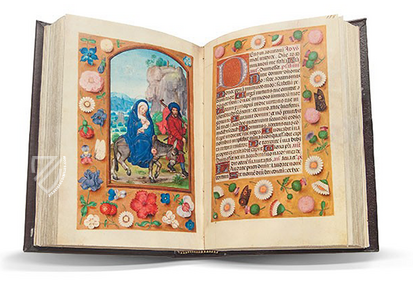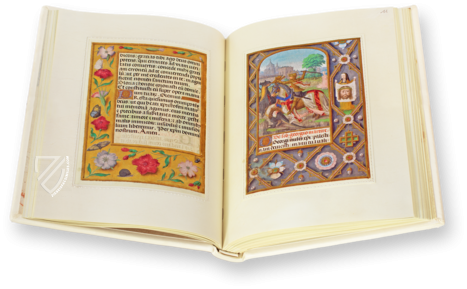Grimani Breviary
The famous Grimani Breviary is considered to be one of the most outstanding testimonials to early 16th century Flemish book illumination. Created around 1510–1520 in Bruges and Ghent, numerous leading illuminators were involved in its creation, including great masters such as Gerard David (around 1460–1523), Simon Bening (around 1483–1561) and Gerard Horenbout (1465–1541). The 1,664 pages of the precious breviary are thoroughly illuminated: in addition to 80 elaborate full-page miniatures and wonderful calendar pages, each of which is a work of art on its own, charmingly arranged borders of flowers, fruit, tendrils, insects, small animals and filigree architecture adorn the liturgical texts. The eponym for this opulent Renaissance masterpiece is the Venetian cardinal, Doge's son and renowned art collector Domenico Grimani (1461–1523), who acquired it in 1520 and whose portrait was immortalized in a gilded bronze medallion on the original velvet binding.
Grimani Breviary
A wonderful calendar is considered to be one of the greatest treasures in the Grimani Breviary: the splendor of the manuscript finds expression in the full-page miniatures with the typical depictions of the course of the agricultural year. For example, there is an especially beautiful scene of winter, which simultaneously depicts an interior space and the events outside under the night’s sky. Yet this is only one of countless grandiose miniatures adorning the manuscript. 120 full-page and numerous smaller miniatures illustrate Christian scenes above all. This exceptional visual experience is brilliantly rounded out by the exuberant decoration of the ornamental and figurative marginal decorations with flowers, animals, fruits, and architectural motifs.
A Highpoint of Flemish Illumination
The Grimani Breviary is considered to be an outstanding specimen of Flemish illumination during the Renaissance because of its exceptionally high-quality and lavish book adornment, a highpoint in the history of illumination! Originating ca. 1510–20 in Flanders, numerous artists with famous names contributed to its genesis, including Gerard Horenbout, Simon and Alexander Bening, Gerard David, and the so-called Master of the David Scenes in the Grimani Breviary.
Miniature Painting at the Highest Level
The manuscript’s namesake, Cardinal Domenico Grimani (1461–1523), acquired the codex ca. 1520 and bequeathed it to the Republic of Venice. Thus, the Grimani Breviary belonged to the San Marco treasury until 1781 and is housed today in the Biblioteca Nazionale Marciana in Venice. A splendid binding with dark-red velvet and gilded bronze ornaments makes the connection to Cardinal Domenico Grimani clear. A portrait of him is recorded on the front cover and a portrait of Doge Giovanni Grimani, his father, is found on the back. In this way, the exterior also fits the outstanding position of the Grimani Breviary as one of the most complex and interesting, beautiful and valuable Flemish manuscripts of the 16th century!
Codicology
- Alternative Titles
- Breviarium Grimani
Breviario Grimani - Size / Format
- 1,664 pages / 27.5 × 19.5 cm
- Origin
- Belgium
- Date
- 1510–1520
- Epochs
- Style
- Language
- Script
- Gothic Textura
- Illustrations
- 80 full-page miniatures; 1550 quarter-pages illuminations depicting vegetation, animals, insects and architecture, but also figural scenes; numerous decorated initials
- Content
- Calendar, Proprium de tempore, Psalter, Offices not related to the church year, Proprium sanctorum
- Artist / School
- Gerard Horenbout
Simon Bening
Alexander Bening (the Master of the First Prayer Book of Maximilian)
Gerard David
Master of the David Scenes in the Grimani Breviary - Previous Owners
- Cardinal Domenico Grimani
Giovanni Grimani
Doge Pascale Cocogna
Grimani Breviary
August: A Noble Hunting Party
Dressed in the finest garments with elaborate feathered hats and riding gorgeous examples of horseflesh, a group of gentlemen and one lady are out for an aristocratic hunt. The figure in light blue with his back turned to us carries a grey hawk or falcon, the ultimate aristocratic accessory. Walking behind the party are their huntsmen, including a Moor – having exotic servants had been a symbol of great wealth since ancient Rome, when blonde-haired slaves from Germania were highly prized.
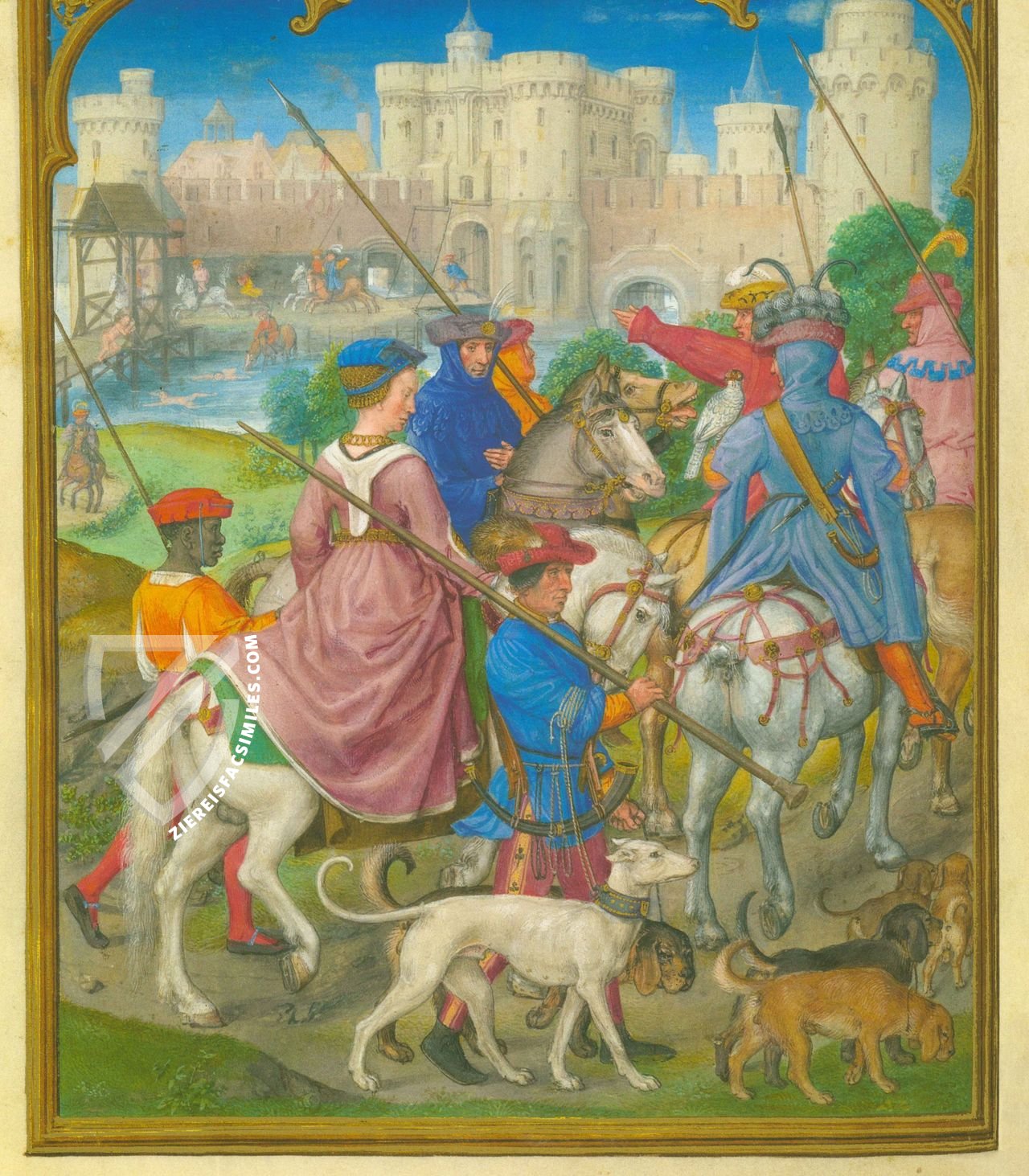
Grimani Breviary
February: Rural Life in the Deep Winter
Gerard Horenbout was responsible for the calendar section of this masterpiece. Upon viewing this manuscript in 1521, the Venetian art historian Marcantonio Michiel declared that the calendar miniatures were especially fine, the February scene the best of all. This is an intimate glimpse of rural life when labor grinds to a halt because of snow.
The sheep stay warm together in their stall, a pig and chickens roam the yard, and a little boy pees out the door into the snow as a cat watches. Icicles hang down over the doorway, revealing a warm interior scene showing prosperous, brightly dressed farmers sitting around a fire, the smoke of which rises through a vent in the roof. In the background, a man and mule march toward a village in the snowy landscape.
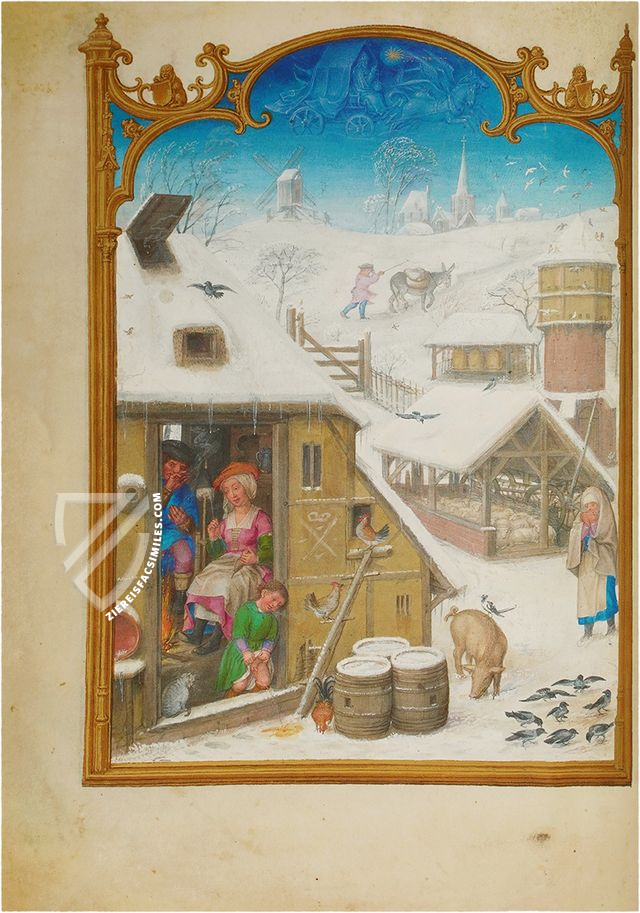
#1 Breviario Grimani
Languages: English, Italian
#2 Breviario Grimani
Language: Italian
The commentary includes an introduction to the manuscript, an examination of the miniatures, and an extensive appendix.
- Treatises / Secular Books
- Apocalypses / Beatus
- Astronomy / Astrology
- Bestiaries
- Bibles / Gospels
- Chronicles / History / Law
- Geography / Maps
- Saints' Lives
- Islam / Oriental
- Judaism / Hebrew
- Single Leaf Collections
- Leonardo da Vinci
- Literature / Poetry
- Liturgical Manuscripts
- Medicine / Botany / Alchemy
- Music
- Mythology / Prophecies
- Psalters
- Other Religious Books
- Games / Hunting
- Private Devotion Books
- Other Genres
- Afghanistan
- Armenia
- Austria
- Belgium
- Belize
- Bosnia and Herzegovina
- China
- Colombia
- Costa Rica
- Croatia
- Cyprus
- Czech Republic
- Denmark
- Egypt
- El Salvador
- Ethiopia
- France
- Germany
- Greece
- Guatemala
- Honduras
- Hungary
- India
- Iran
- Iraq
- Israel
- Italy
- Japan
- Jordan
- Kazakhstan
- Kyrgyzstan
- Lebanon
- Liechtenstein
- Luxembourg
- Mexico
- Morocco
- Netherlands
- Palestine
- Panama
- Peru
- Poland
- Portugal
- Romania
- Russia
- Serbia
- Spain
- Sri Lanka
- Sweden
- Switzerland
- Syria
- Tajikistan
- Turkey
- Turkmenistan
- Ukraine
- United Kingdom
- United States
- Uzbekistan
- Vatican City
- A. Oosthoek, van Holkema & Warendorf
- Aboca Museum
- Ajuntament de Valencia
- Akademie Verlag
- Akademische Druck- u. Verlagsanstalt (ADEVA)
- Aldo Ausilio Editore - Bottega d’Erasmo
- Alecto Historical Editions
- Alkuin Verlag
- Almqvist & Wiksell
- Amilcare Pizzi
- Andreas & Andreas Verlagsbuchhandlung
- Archa 90
- Archiv Verlag
- Archivi Edizioni
- Arnold Verlag
- ARS
- Ars Magna
- ArtCodex
- AyN Ediciones
- Azimuth Editions
- Badenia Verlag
- Bärenreiter-Verlag
- Belser Verlag
- Belser Verlag / WK Wertkontor
- Benziger Verlag
- Bernardinum Wydawnictwo
- BiblioGemma
- Biblioteca Apostolica Vaticana (Vaticanstadt, Vaticanstadt)
- Bibliotheca Palatina Faksimile Verlag
- Bibliotheca Rara
- Boydell & Brewer
- Bramante Edizioni
- Bredius Genootschap
- Brepols Publishers
- British Library
- C. Weckesser
- Caixa Catalunya
- Canesi
- CAPSA, Ars Scriptoria
- Caratzas Brothers, Publishers
- Carus Verlag
- Casamassima Libri
- Centrum Cartographie Verlag GmbH
- Chavane Verlag
- Christian Brandstätter Verlag
- Circulo Cientifico
- Club Bibliófilo Versol
- Club du Livre
- CM Editores
- Collegium Graphicum
- Collezione Apocrifa Da Vinci
- Comissão Nacional para as Comemorações dos Descobrimentos Portugueses
- Coron Verlag
- Corvina
- CTHS
- D. S. Brewer
- Damon
- De Agostini/UTET
- De Nederlandsche Boekhandel
- De Schutter
- Deuschle & Stemmle
- Deutscher Verlag für Kunstwissenschaft
- DIAMM
- Droz
- E. Schreiber Graphische Kunstanstalten
- Ediciones Boreal
- Ediciones Grial
- Ediclube
- Edições Inapa
- Edilan
- Editalia
- Edition Deuschle
- Edition Georg Popp
- Edition Leipzig
- Edition Libri Illustri
- Editiones Reales Sitios S. L.
- Éditions de l'Oiseau Lyre
- Editions Medicina Rara
- Editorial Casariego
- Editorial Mintzoa
- Editrice Antenore
- Editrice Velar
- Edizioni Edison
- Egeria, S.L.
- Eikon Editores
- Electa
- Emery Walker Limited
- Enciclopèdia Catalana
- Eos-Verlag
- Ephesus Publishing
- Ernst Battenberg
- Eugrammia Press
- Extraordinary Editions
- Fackelverlag
- Facsimila Art & Edition
- Facsimile Editions Ltd.
- Facsimilia Art & Edition Ebert KG
- Faksimile Verlag
- Feuermann Verlag
- Folger Shakespeare Library
- Franco Cosimo Panini Editore
- Friedrich Wittig Verlag
- Fundación Hullera Vasco-Leonesa
- G. Braziller
- Gabriele Mazzotta Editore
- Gebr. Mann Verlag
- Gesellschaft für graphische Industrie
- Getty Research Institute
- Giovanni Domenico de Rossi
- Giunti Editore
- Graffiti
- Grafica European Center of Fine Arts
- Guido Pressler
- Guillermo Blazquez
- Gustav Kiepenheuer
- H. N. Abrams
- Harrassowitz
- Harvard University Press
- Helikon
- Hendrickson Publishers
- Henning Oppermann
- Herder Verlag
- Hes & De Graaf Publishers
- Hoepli
- Holbein-Verlag
- Houghton Library
- Hugo Schmidt Verlag
- Idion Verlag
- Il Bulino, edizioni d'arte
- ILte
- Imago
- Insel Verlag
- Insel-Verlag Anton Kippenberger
- Instituto de Estudios Altoaragoneses
- Instituto Nacional de Antropología e Historia
- Introligatornia Budnik Jerzy
- Istituto dell'Enciclopedia Italiana - Treccani
- Istituto Ellenico di Studi Bizantini e Postbizantini
- Istituto Geografico De Agostini
- Istituto Poligrafico e Zecca dello Stato
- Italarte Art Establishments
- Jan Thorbecke Verlag
- Johnson Reprint Corporation
- Josef Stocker
- Josef Stocker-Schmid
- Jugoslavija
- Karl W. Hiersemann
- Kasper Straube
- Kaydeda Ediciones
- Kindler Verlag / Coron Verlag
- Kodansha International Ltd.
- Konrad Kölbl Verlag
- Kurt Wolff Verlag
- La Liberia dello Stato
- La Linea Editrice
- La Meta Editore
- Lambert Schneider
- Landeskreditbank Baden-Württemberg
- Leo S. Olschki
- Les Incunables
- Liber Artis
- Library of Congress
- Libreria Musicale Italiana
- Lichtdruck
- Lito Immagine Editore
- Lumen Artis
- Lund Humphries
- M. Moleiro Editor
- Maison des Sciences de l'homme et de la société de Poitiers
- Manuscriptum
- Martinus Nijhoff
- Maruzen-Yushodo Co. Ltd.
- MASA
- Massada Publishers
- McGraw-Hill
- Metropolitan Museum of Art
- Militos
- Millennium Liber
- Müller & Schindler
- Nahar - Stavit
- Nahar and Steimatzky
- National Library of Wales
- Neri Pozza
- Nova Charta
- Oceanum Verlag
- Odeon
- Orbis Mediaevalis
- Orbis Pictus
- Österreichische Staatsdruckerei
- Oxford University Press
- Pageant Books
- Parzellers Buchverlag
- Patrimonio Ediciones
- Pattloch Verlag
- PIAF
- Pieper Verlag
- Plon-Nourrit et cie
- Poligrafiche Bolis
- Presses Universitaires de Strasbourg
- Prestel Verlag
- Princeton University Press
- Prisma Verlag
- Priuli & Verlucca, editori
- Pro Sport Verlag
- Propyläen Verlag
- Pytheas Books
- Quaternio Verlag Luzern
- Reales Sitios
- Recht-Verlag
- Reichert Verlag
- Reichsdruckerei
- Reprint Verlag
- Riehn & Reusch
- Roberto Vattori Editore
- Rosenkilde and Bagger
- Roxburghe Club
- Salerno Editrice
- Saltellus Press
- Sandoz
- Sarajevo Svjetlost
- Schöck ArtPrint Kft.
- Schulsinger Brothers
- Scolar Press
- Scrinium
- Scripta Maneant
- Scriptorium
- Shazar
- Siloé, arte y bibliofilia
- SISMEL - Edizioni del Galluzzo
- Sociedad Mexicana de Antropología
- Société des Bibliophiles & Iconophiles de Belgique
- Soncin Publishing
- Sorli Ediciones
- Stainer and Bell
- Studer
- Styria Verlag
- Sumptibus Pragopress
- Szegedi Tudomànyegyetem
- Taberna Libraria
- Tarshish Books
- Taschen
- Tempus Libri
- Testimonio Compañía Editorial
- Thames and Hudson
- The Clear Vue Publishing Partnership Limited
- The Facsimile Codex
- The Folio Society
- The Marquess of Normanby
- The Richard III and Yorkist History Trust
- Tip.Le.Co
- TouchArt
- TREC Publishing House
- TRI Publishing Co.
- Trident Editore
- Tuliba Collection
- Typis Regiae Officinae Polygraphicae
- Union Verlag Berlin
- Universidad de Granada
- University of California Press
- University of Chicago Press
- Urs Graf
- Vallecchi
- Van Wijnen
- VCH, Acta Humaniora
- VDI Verlag
- VEB Deutscher Verlag für Musik
- Verlag Anton Pustet / Andreas Verlag
- Verlag Bibliophile Drucke Josef Stocker
- Verlag der Münchner Drucke
- Verlag für Regionalgeschichte
- Verlag Styria
- Vicent Garcia Editores
- W. Turnowski Ltd.
- W. Turnowsky
- Waanders Printers
- Wiener Mechitharisten-Congregation (Wien, Österreich)
- Wissenschaftliche Buchgesellschaft
- Wissenschaftliche Verlagsgesellschaft
- Wydawnictwo Dolnoslaskie
- Xuntanza Editorial
- Zakład Narodowy
- Zollikofer AG

